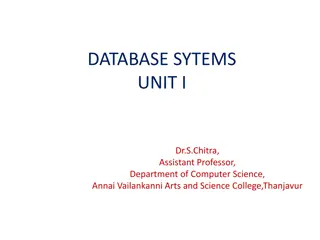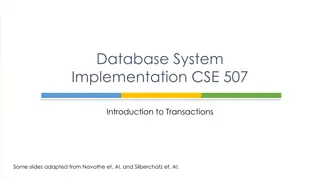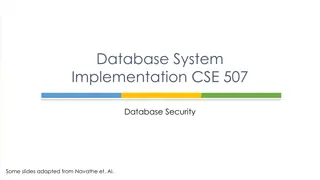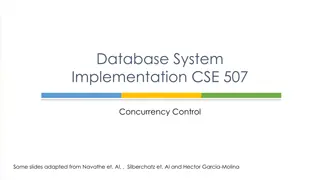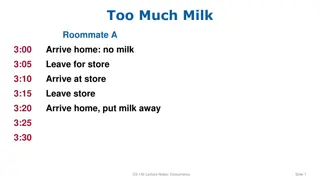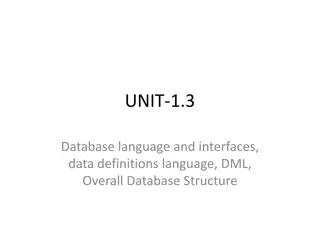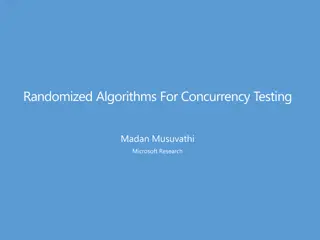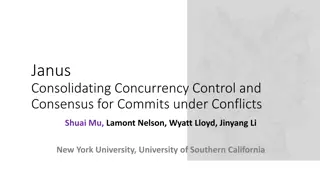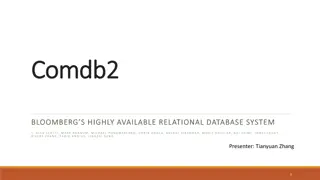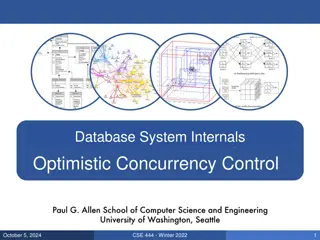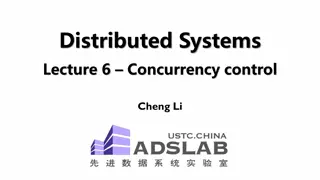Database System Concurrency Control and Transactions Overview
Studying relational models, SQL, database system architecture, operator implementations, data layouts, and query optimization laid the foundation for advanced topics like Concurrency Control and Recovery. Discover how transactions group related actions, ACID properties ensure data integrity, and the challenges of concurrent programming are simplified through transactions. Explore distributed and parallel query processing alongside future lecture topics in the exciting world of database systems.
Download Presentation

Please find below an Image/Link to download the presentation.
The content on the website is provided AS IS for your information and personal use only. It may not be sold, licensed, or shared on other websites without obtaining consent from the author. Download presentation by click this link. If you encounter any issues during the download, it is possible that the publisher has removed the file from their server.
E N D
Presentation Transcript
6.5830 Lecture 10 Transactions 10/16/2022 Project proposals are due today Quiz 1 results (Wednesday)
Where Are We? So far: Studied relational model & SQL Learned basic architecture of a database system Studied different operator implementations Looked at several data layouts Saw how query optimizer works with statistics to select plans and operators What next: Concurrency Control and Recovery: How to ensure correctness in the presence of modifications and failures to the database Distributed and parallel query processing Advanced Topics
Concurrency Control Key Idea: Transactions Group related sequence of actions so they are all or nothing If the system crashes, partial effects are not seen Other transactions do not see partial effects A set of implementation techniques that provides this abstraction with good performance
ACID Properties of Transactions A tomicity many actions look like one; all or nothing C onsistency database preserves invariants I solation concurrent actions don t see each other s results D urability completed actions in effect after crash ( recoverable )
Concurrent Programming Is Hard A = 0 A = 0 1 A = 0 1 1 Example: T1 t = A t = t + 1 A = t Looks correct! But maybe not if other updates to A are interleaved! Suppose T1 increment runs just before T2 increment T1 increment will be lost T2 t = A t = t + 1 A = t Conventional approach: programmer adds locks But must reason about other concurrent programs
Transactions Dramatically Simplify Concurrent Programming Concurrent actions are serially equivalent I.e., appear to have run one after the other Programmer does not have to think about what is running at the same time! One of the big ideas in computer science
SQL Syntax BEGIN TRANSACTION Followed by SQL operations that modify database COMMIT: make the effects of the transaction durable After COMMIT returns database guarantees results present even after crash And results are visible to other transactions ABORT: undo all effects of the transaction
This Lecture: Atomicity Atomicity many actions like one; all or nothing In reality, actions take time! To get atomicity, to prevent multiple actions from interfering with each other I.e., are Isolated Will return to Durability in 2 lectures E.g., how to recover a database after a crash into a state where no partial transactions are present
Consistency Preservation of invariants Usually expressed in terms of constraints E.g., primary keys / foreign keys Triggers Example: no employee makes more than their manager Requires ugly non-SQL syntax (e.g. PL/pgSQL) Often done in the application
Postgres PL/pgSQL Trigger Example CREATE FUNCTION sal_check() RETURNS trigger AS $sal_check$ DECLARE mgr_sal integer; BEGIN IF NEW.salary IS NOT NULL THEN SELECT INTO mgr_sal salary FROM emp JOIN manages ON NEW.eid = manages.eid AND emp.eid = manages.eid LIMIT 1; IF (mgr_sal < NEW.salary) THEN RAISE EXCEPTION 'employee cannot make more than manager ; END IF; END IF; RETURN NEW; END; $sal_check$ LANGUAGE plpgsql; CREATE TRIGGER eid_sal BEFORE INSERT OR UPDATE ON emp FOR EACH ROW EXECUTE FUNCTION sal_check(); NEW is the record being added mgr_sal is a local variable Query finds the salary of one manager Check salary (if no manager, mgr_sal is NULL) Declare that we want to call sal_check every time a record changes or is added to emp
How Can We Isolate Actions? Serialize execution: one transaction at a time Problems with this? No ability to use multiple processors Long running transactions starve others Goal: allow concurrent execution while preserving serial equivalence Concurrency control algorithms do this
Serializability An ordering of actions in concurrent transactions that is serially equivalent T1 RA RB WA WB WB Serially equivalent to T1 then T2 T1 RA WA RB T2 T2 RA RB WA WB RB WB RA: Read A WA: Write A, may depend on anything read previously RA WA A/B are objects e.g., records, disk pages, etc Assume arbitrary application logic between reads and writes
Serializability An ordering of actions in concurrent transactions that is serially equivalent T1 RA RB WA WB WB Not serially equivalent T2 s write to A is lost, couldn t occur in a serial schedule In T1-T2, T2 should see T1 s write to A In T2-T1, T1 should see T2 s write to A T1 RA WA RB T2 RA RB WA WB RB WB T2 RA WA RA: Read A WA: Write A, may depend on anything read previously A/B are objects e.g., records, disk pages, etc Assume arbitrary application logic between reads and writes
Testing for Serializability Conflict Serializability View Serializability Any schedule that is conflict serializable is view serializable, but not vice-versa
View Serializability A particular ordering of instructions in a schedule S is view equivalent to a serial ordering S' iff: Every value read in S is the same value that was read by the same read in S'. The final write of every object is done by the same transaction T in S and S Less formally, all transactions in S view the same values they view in S', and the final state after the transactions run is the same.
View Serializability Example S T1 RA=A1 WA A2 RB=B1 WB B2 T2 RA = A2 WA A3 RB=B2 WB B3 S T1 RA= A1 WA A2 RB = B1 WB B2 T2 RA = A2 WA A3 RB = B2 WB B3 Same values read in both schedules T2 does final write in both schedules Every value read in S is the same value that was read by the same read in S'. The final write of every object is done by the same transaction T in S and S'
https://clicker.mit.edu/6.5830/ Is the following schedule view serializable? T1 T2 RA=A1 RA=A1 WA->A2 WB->B2 WB->B3 A particular ordering of instructions in a schedule S is view equivalent to a serial ordering S' iff: Every value read in S is the same value that was read by the same read in S'. The final write of every object is done by the same transaction T in S and S A)Yes B)No
View Serializability Limitations Must test against each possible serial schedule to determine serial equivalence NP-Hard! (For N concurrent transactions, there are 2N possible serial schedules) No protocol to ensure view serializability as transactions run Conflict serializability addresses both points
Conflicting Operations Two operations are said to conflict if: Both operations are on the same object At least one operation is a write E.g., T1WA conflicts with T2RA, but T1RA does not conflict with T2RA T1 R W T2 R W
Conflict Serializability A schedule is conflict serializable if it is possible to swap non-conflicting operations to derive a serial schedule. Equivalently For all pairs of conflicting operations {O1 in T1, O2 in T2} either O1 always precedes O2, or O2 always precedes O1. T1 T2 : T1 precedes T2
Example T1 RA WA RB WB Not conflict serializable! T2 RA WA T1 RA WA RB WB Conflict serializable! can reorder non-conflicting ops to get serial schedule T2 T2 T1 RA WA RB WB T1 T2 O1 T1 T2 RA WA RA WA RB WB O2 T2 T1 T1 T2 RB WB RB WB In conflict serializable schedule, For all pairs of conflicting operations {O1 in T1, O2 in T2} either O1 always precedes O2, or O2 always precedes O1.
Precedence Graph Given transactions Ti and Tj, Create an edge from Ti Tj if: Ti reads/writes some A before Tj writes A RATi WATj orWATi WATj Ti writes some A before Tj reads A WATi RATj or If there are cycles in this graph, schedule is not conflict serializable
Non-Serializable Example Precedence Graph T1 RA WA RB WB Create an edge from Ti Tj if: T2 RA WA T2 T1 RB WB Cycle! Ti reads/writes some A before Tj writes A, or RATi WATj orWATi WATj Ti writes some A before Tj reads A WATi RATj
Serializable Example Precedence Graph T1 RA WA RB WB Create an edge from Ti Tj if: T2 RA WA T2 T1 RB WB No Cycles! Ti reads/writes some A before Tj writes A, or RATi WATj orWATi WATj Ti writes some A before Tj reads A WATi RATj
Recap: 3 Ways to Test for Conflict Serializabiliy 1. Check: For all pairs of conflicting operations {O1 in T1, O2 in T2} either a. O1 always precedes O2, or b. O2 always precedes O1. 2. Swap non-conflicting operations to get serial schedule 3. Build precedence graph, check for cycles
Clicker: https://clicker.mit.edu/6.5830/ Is this schedule conflict serializable? T1 T2 T3 A)Yes B)No RA RB WA RB WB WB RA WA COMMIT COMMIT COMMIT
T3 Study Break T2 Is this schedule conflict serializable? T1 T1 T2 T3 RA RB No! WA RB WB WB RA WA COMMIT COMMIT COMMIT
https://clicker.mit.edu/6.5830/ T1 T2 T3 RA WA WA WA RB WB Is this schedule A) neither view nor conflict serializable B) conflict serializable but not view serializable C) view serializable but not conflict serializable D) conflict and view serializable
View vs Conflict Serializable Testing for view serializability is NP-Hard Have to consider all possible orderings Conflict serializability used in practice Not because of NP-Hardness Because we have a way to enforce it as transactions run Example of schedule that is view serializable but not conflict serializable: T1 RA WA RB WB T2 T3 Cycle! T2 Blind Writes WA T1 WA Equivalent to T1, T2, T3 Conflict serializability does not permit this Only happens with blind writes T3
View vs Conflict Serializable Conflict Serializability View Serializability Any schedule that is conflict serializable is view serializable, but not vice-versa
Implementing Conflict Serializability T1 R W Several different protocols Today: Two Phase Locking (2PL) Basic idea: Acquire a shared (S) lock before each read of an object Acquire an exclusive (X) lock before each write of an object Several transactions can hold an S lock Only one transaction can hold an X lock If a transaction cannot acquire a lock it waits ( blocks ) T2 R W T1 S X T2 S X Lock Compatibility Table Conflicting operations (from def. of conflict serializability) are not compatible with each other
When to Release Locks T1 Xlock A RA WA Rel A Xlock B RB WB Rel B T2 After each op completes? Or after xaction is done with variable? No! Example of problem T2 sneaks in and updates A and B before T1 updates B Xlock A RA WA Xlock B RB WB Rel A,B This schedule is not serializable
Solution: Two Phase Locking A transaction cannot release any locks until it has acquired all of its locks
Example, Revisited T1 Xlock A RA WA Rel A Xlock B RB WB Rel B T2 Rule: A transaction cannot release any locks until it has acquired all of its locks Not allowed Xlock A RA WA Xlock B RB WB Rel A,B This schedule is not serializable
Example, Revisited Rule: A transaction cannot release any locks until it has acquired all of its locks Serial schedule defined by lock points Where they acquire last lock T1 Xlock A RA WA Xlock B Rel A RB WB Rel B T2 Lock point Acquired all locks so can release Xlock A RA WA Xlock B RB WB Rel A,B Lock point This schedule *is* serializable
Correctness Intuition Once a transaction T reached its lock point: T s place in serial order is set Any transactions that haven't acquired all their locks can t take any conflicting actions until after T releases locks Ordered later Any transactions which already have all their locks must have completed their conflicting actions (released their locks) before T can proceed Ordered earlier
Two Phase Locking (2PL) Protocol Before every read, acquire a shared lock Before every write, acquire an exclusive lock (or "upgrade") a shared to an exclusive lock Release locks only after last lock has been acquired, and ops on that object are finished
Can you think of any potential problems with 2PL?
Refining 2PL Problems: Deadlocks Cascading Aborts How do we know when we are done with all operations on an object?
Deadlocks Possible for Ti to hold a lock Tj needs, and vice versa T1 RA WA RB WB T2 Waits-for graph Cycle Deadlock T1 RB WB T2 T1 waits for T2 T2 waits for T1 RA WA
Complex Deadlocks Are Possible T1 RA WA RB WB T2 T3 RB WB RC RA WA T3 waits for T1 T1 waits for T2 T2 waits for T3 RC WC Waits-for graph Cycle Deadlock T1 T2 T3
Resolving Deadlock Solution: abort one of the transactions Recall: users can abort too T1 RA WA RB WB T2 T3 RB WB RC RA WA T3 waits for T1 T1 waits for T2 Waits-for graph Cycle Deadlock T1 RC WC T2 waits for T3 T2 Equivalent to T2 - T1 T3
Cascading Aborts Problem: if T1 aborts, and T2 read something T1 wrote, T2 also needs to abort T1 Xlock A RA WA Xlock B Rel A RB WB Rel B T2 Xlock A RA WA If T1 aborts here T2 also needs to abort, It reads T1 s write of A Xlock B RB WB Rel A,B
Can you think of a 2PL variant which neither requires deadlock detection nor has cascading aborts?
Strict Two-Phase Locking Can avoid cascading aborts by holding exclusive locks until end of transaction Ensures that transactions never read other transaction s uncommitted data
Strict Two-Phase Locking Protocol Before every read, acquire a shared lock Before every write, acquire an exclusive lock (or "upgrade") a shared to an exclusive lock Release locks only after last lock has been acquired, and ops on that object are finished Release shared locks only after last lock has been acquired, and ops on that object are finished Release exclusive locks only after the transaction commits Ensures cascadeless-ness



